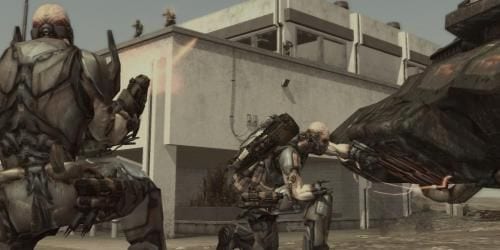
There are two things that any developer should remember when porting a game from the PC to the current generation of consoles. Well, actually, there are much more than two things that developers should remember, but in the case of Enemy Territory: Quake Wars, there are at least two things that developer Nerve Software forgot when they ported the game to the Xbox 360 and PlayStation 3.
First and foremost: Do not, under any circumstances, let the console gamer think that an inferior product is being offered to them, for any reason. If something must be left out of the conversion, add something to compensate. Never take something out without an awfully good reason for doing so.
Surely, the above sounds like common sense, and yet the lack of any sort of fine attribute upgrades does not only stick out as a major omission, but downgrades a huge strategic component of what made the PC version such a fun (not to mention refreshingly difficult to master) experience. Xbox 360 and PlayStation 3 gamers get attribute upgrades, but only through the gaining of “levels”, as if this was a low-grade RPG situation in which all aspects of a player are simultaneously improved. While the reasons an RPG would implement a system like this are understandable (if outdated), it’s difficult to find any possible benefit to implementing such an upgrade system in a setting whose maximum possible playtime is four 20-minute-long scenarios.
The second thing that developers should remember in the transition from PC to console gaming: Do not insult our choice of hardware. It seems that console gamers haven’t figured out how to aim using the right analog thumbstick — at least, that’s the implication of an auto-aim feature that had me feeling like a sniper in seconds, whether I was looking through the gun sight or not. Most of the time, auto-aiming is so sticky that you can fire wildly into a crowd and cut down enemies as if you’re picking them off at point-blank range.
Now, I’ll be the first to admit, I liked the broken auto-aim at first. First-person shooters are by no means my forte, and to be able to play one and think, however briefly, that I might actually have a chance with the game in the online environment was sort of appealing. I even found myself easily succeeding in the normal-level single-player campaigns, something I can’t often claim. And yet, I got online, and what happened?
Well, I got smoked, of course.
Everyone else had the same auto-aiming “advantage” that I did, thus nullifying it entirely and putting me back on the first-person shooter playing field that I’m used to. In fact, the people I was playing with had long since discovered the advantages of the auto-aim, along with the proper ways in which to exploit those advantages and make me look like the total and utter newbie that I usually come off as in these situations. At this point it became obvious that the auto-aim was not a boon to the console player, but a hindrance. Rather than reward the skill of those who have mastered the mechanics of their mice, knowing exactly how far they need to move the hardware to perform a headshot in the software, the console version rewards knowing the distance that each gun can shoot combined with the ammo-saving proclivities of an action hero. It should be obvious which provides the more satisfying play experience.
Despite the failings in the conversion from PC to console gaming that can’t help but dominate the conversation on the console port of Enemy Territory: Quake Wars, it’s still not that bad a game, and it has many of the same things going for it that the PC version did. For one, there’s no huge, forced storyline in the single-player mode, allowing you to have a complete start-to-finish gaming experience in about an hour-and-a-half, every time. It’s like a “casual” FPS experience, which just isn’t something that can easily be found. There are a few “wow” moments, like when you walk through the transporter in a desert landscape and come out the other end into snow-filled terrain, complete with hidden surprises and underground structures. The five character classes are very well balanced as well, making play as any of the five a rewarding experience — not everyone will want to be a soldier or a medic all the time (on the human side), as there are truly benefits to playing as a covert ops agent as well.
Still, the strengths of the game have been well-documented already, something that forces one to focus on the weaknesses of this console version. That there seem to be no clear improvements to the console version is perhaps its biggest failing — by giving us nothing positive to concentrate on, we have no choice but to concentrate on the negative. As such, anyone truly wishing to get the best possible Quake Wars experience should make sure they have the PC power to handle the original, superior version of the game.

![Call for Papers: All Things Reconsidered [MUSIC] May-August 2024](https://www.popmatters.com/wp-content/uploads/2024/04/all-things-reconsidered-call-music-may-2024-720x380.jpg)



